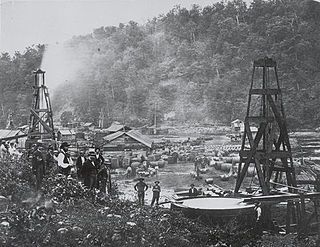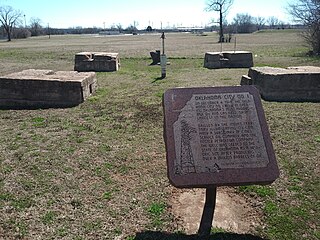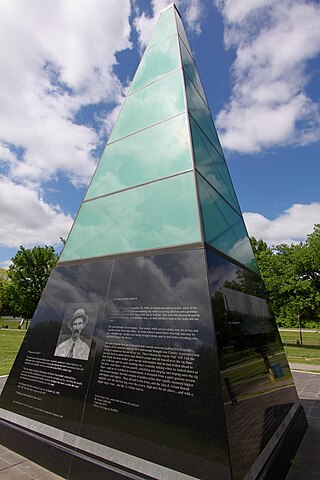
Spindletop is an oil field located in the southern portion of Beaumont, Texas, in the United States. The Spindletop dome was derived from the Louann Salt evaporite layer of the Jurassic geologic period. On January 10, 1901, a well at Spindletop struck oil. The Spindletop gusher blew for 9 days at a rate estimated at 100,000 barrels (16,000 m3) of oil per day. Gulf Oil and Texaco, now part of Chevron Corporation, were formed to develop production at Spindletop. The Spindletop discovery led the United States into the oil age. Prior to Spindletop, oil was primarily used for lighting and as a lubricant. Because of the quantity of oil discovered, burning petroleum as a fuel for mass consumption suddenly became economically feasible.

Cushing is a city in Payne County, Oklahoma, United States. The population was 7,826 at the time of the 2010 census, a decline of 6.5% since 8,371 in 2000. Cushing was established after the Land Run of 1891 by William "Billy Rae" Little. It was named for Marshall Cushing, private secretary to U.S. Postmaster General John Wanamaker.

Drumright is a city in Creek and Payne counties in the U.S. state of Oklahoma. It began as an oil boom town. However, the population has declined as oil production has waned in the area. The population was 2,907 at the 2010 census, a figure almost unchanged from 2,905 in 2000. Drumright and nearby Cushing were at the center of the large, productive Cushing-Drumright Oil Field in the 1910s and 1920s. Now Drumright is home to a festival called The Drumright Monthly Market, where hundreds of visitors come on the first Saturday of every month, seeking crafts and delicacies from all over the region. Drumright is also home to The yearly OilPatch Parade and Jamboree Jog, Annual Cruising the Hills car show, Joseph's Restaurant, and Babe Ruth played on our very own baseball field. We have a sign dedicated to Babe Ruth at the entry to the sports complex area. You can find out more from Jamey Martin at Joseph's and the Museum.

The Mid-continent oil field is a broad area containing hundreds of oil fields in the U.S. states of Arkansas, Kansas, Louisiana, New Mexico, Oklahoma and Texas. The area, which consists of various geological strata and diverse trap types, was discovered and exploited during the first half of the 20th century. Most of the crude oil found in the onshore Mid-continent oil field is considered to be of the mixed base or intermediate type.

The Barnett Shale is a geological formation located in the Bend Arch-Fort Worth Basin. It consists of sedimentary rocks dating from the Mississippian period in Texas. The formation underlies the city of Fort Worth and underlies 5,000 mi2 (13,000 km2) and at least 17 counties.
Thomas Baker Slick Sr. was born in Shippenville, Clarion County, Pennsylvania to Johnson M. and Mary A. Baker Slick. He became notable in 1912 for discovering Oklahoma's then-largest oil field, the Cushing Oil Field.

The oil rush in America started in Titusville, Pennsylvania, in the Oil Creek Valley when Edwin L. Drake struck "rock oil" there in 1859. Titusville and other towns on the shores of Oil Creek expanded rapidly as oil wells and refineries shot up across the region. Oil quickly became one of the most valuable commodities in the United States and railroads expanded into Western Pennsylvania to ship petroleum to the rest of the country.
Albert A. Rollestone was a Presbyterian philanthropist and Oklahoma oil pioneer. A. A. Rollestone helped fund the first institution of modern education in Iran at the turn of the 20th century. A. A. Rollestone provided funding for the iconic central building of Alborz College, Iran's model of modern education.

The First Oil Well in Western Canada, also known as Lineham Discovery Well No. 1, is a defunct oil well and national historic site of Canada. Which commemorates the September 21, 1902 oil strike in what is now Waterton Lakes National Park, Alberta. The oil well originally drilled in 1902, was the first productive oil well in the Western Canadian provinces.
The R.E. Hoy No. 1 Oil Well was constructed by the Sinclair Oil & Refining Corporation in September 1916. It has been listed on the National Register of Historic Places since 1986. Milton C. Garber and his brother Bert Garber hired geologist Dorsey Hager to determine potential drilling locations on their properties. The Garber brothers contracted Harry F. Sinclair to construct a well on R. E. Hoy's farm. The well was drilled at a depth of 1,130–56 feet. At 4:00 AM on September 10, the oil began to flow, starting out at 90 to 100 barrels per day (16 m3/d). The Hoy sand was the first successful sand of the Garber-Covington oil field, and the first well to be drilled with the advice of a geologist. From 1916 to 1940 the well utilized primary production, adding secondary methods of gas injection and waterflooding. At the time of nomination, the Hoy well was producing 4 barrels per day (0.64 m3/d), and had been in operation for 69 years.

Jackson Barnett was an Oklahoma landowner of the Muscogee or Creek people, who became known as "the world's richest Indian" when oil wells on his land produced as much as $24 million worth of oil starting in 1912. Barnett's 12.5% royalty share was worth between $3 million and $4 million, but due to Barnett's illiteracy and a court finding that Barnett was legally incompetent from a head injury, his money was administered by the Creek County courts and the U.S. Department of the Interior until 1920.
The First Oil Well in Oklahoma was drilled in 1885 in Atoka County, Choctaw Nation, Indian Territory, though it was not completed until 1888.

The history of oil production in California began in the late 19th century. In 1903, California became the leading oil-producing state in the US, and traded the number one position back-and forth with Oklahoma through the year 1930. As of 2022, California produced 3% of the crude oil of the nation, behind Texas, New Mexico, North Dakota, Alaska, Colorado, and Oklahoma. In the past century, California's oil industry grew to become the state's number one GDP export and one of the most profitable industries in the region. The history of oil in the state of California, however, dates back much earlier than the 19th century. For thousands of years prior to European settlement in America, Native Americans in the California territory excavated oil seeps. By the mid-19th century, American geologists discovered the vast oil reserves in California and began mass drilling in the Western Territory. While California's production of excavated oil increased significantly during the early 20th century, the accelerated drilling resulted in an overproduction of the commodity, and the federal government unsuccessfully made several attempts to regulate the oil market.
The Wheeler No. 1 Oil Well was the first well drilled in the Drumright-Cushing Oil Field of northeast Oklahoma, near Drumright. The success of the well, drilled in 1912 by Thomas Baker Slick, Sr., led to the development of the Cushing field and gave impetus to the early development of Oklahoma oilfields. The Drumright-Cushing field would go on to produce 310,000 barrels of oil a day at its peak in May 1917. The well made Slick's name as "King of the Wildcatters".

The Cushing Oil Field, also known as the Cushing-Drumright Oil Field, is an oil field in northeastern Oklahoma, part of the Mid-Continent oil province. The 10-mile (16 km) by 3-mile (4.8 km) field includes southeastern Payne County, northwestern Creek County, and northeastern Lincoln County. Named for its primary supply center at Cushing, Oklahoma, the field was developed from 1912.

The Oklahoma City Discovery Well was the first successful oil well to be drilled in Oklahoma City, Oklahoma. The December 4, 1928 discovery opened the Oklahoma City Oil Field to extensive exploitation, creating an oil boom that sustained the area through the Great Depression. Because much of the oil was under the existing city, the Oklahoma City field pioneered the use of directional drilling to allow lateral displacement of well bores to reach deposits under developed areas.

Nellie Johnstone No. 1 was the first commercially productive oil well in Oklahoma. Completed on April 15, 1897, the well was drilled in the Bartlesville Sand near Bartlesville, opening an era of oil exploration and development in Oklahoma. It was abandoned as a well in 1964. The site was donated to the city of Bartlesville and is now a park, listed on the National Register of Historic Places, featuring a restored drilling rig.
David Harold "Dry Hole" Byrd was a noted Texan producer of petroleum, and a co-founder of the Civil Air Patrol. Byrd's cousin, polar explorer Richard E. Byrd, named Antarctica's Harold Byrd Mountains for him.
The Big Muddy oil field is an oil field in Converse County, Wyoming, between Casper and Glenrock.

The discovery of the Glenn Pool Oil Reserve in 1905 brought the first major oil pipelines into Oklahoma, and instigated the first large scale oil boom in the state. Located near what was—at the time—the small town of Tulsa, Oklahoma, the resultant establishment of the oil fields in the area contributed greatly to the early growth and success of the city, as Tulsa became the petroleum and transportation center of the state, and the world.















